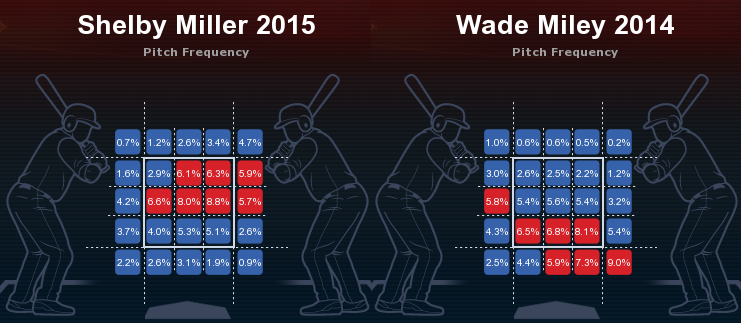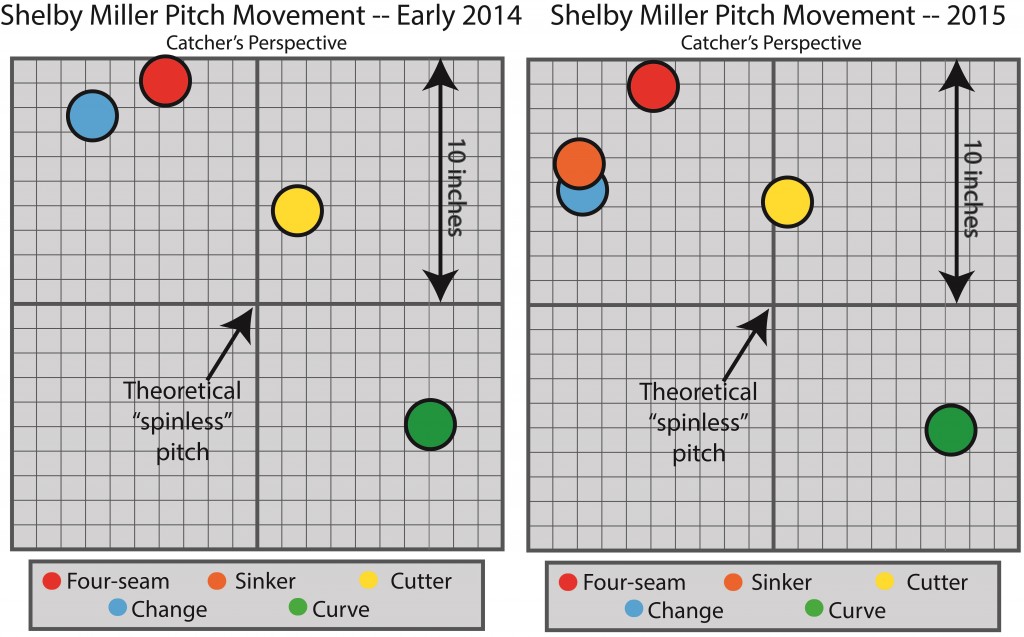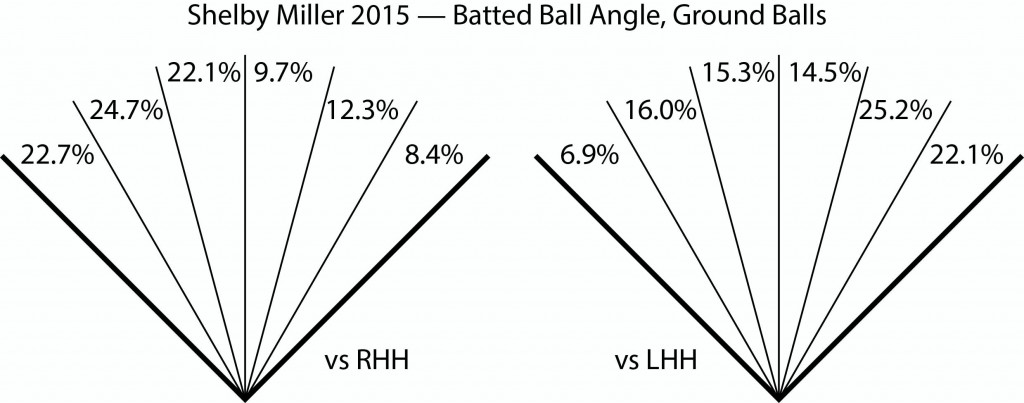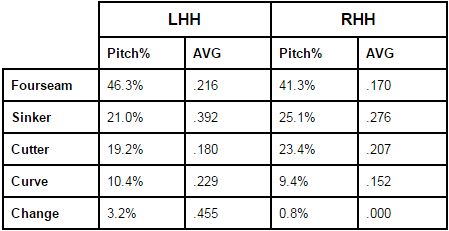3 Simple Rules for Starting Our Shelby Miller
Shelby Miller is an unusual pitcher. Remaking himself partway through 2014, even the batted ball exit velocity data shows him to have been a contact manager last year — and you have no farther to look than the quality of the contact against him to see that his 3.02 ERA last year wasn’t as much about luck as you might think at first blush. Miller is a five-pitch pitcher, working with three fastballs with very different movement, a change he uses sparingly, and a curve that has been very effective.
That’s the kind of thing that is going to be really fun to watch this year, especially if it all works, or if he continues to change. Understanding who he’s been recently, however, means setting him up to succeed — differently.
Watching Miller this spring, it’s been clear that while he is a ground ball pitcher, he’s not a ground ball pitcher the way most are. To sustain a high ground ball rate, most pitchers do one of two things (or both): throw a ton of sinkers with a lot of vertical separation from a fourseam, in terms of movement, or batter the bottom of the strike zone.
Miller does neither of those things.
Instead, Miller appears to be a ground ball pitcher because weakly hit balls don’t go very far. In terms of launch angle, Miller also appears to be a weak liner machine, which makes for some additional outs but also some lazy singles. Miller’s success last year wasn’t about making hitters miss over the ball (what you’d expect from a sinker), or making hitters get out in front (the natural loft of a swing means if you’re early, you’re probably hitting the ball on the ground). Miller worked relatively high in the zone, and made hitters miss horizontally, not vertically.
Compare Miller’s pitch frequency map from last year with that of another grounder-leaning starter for the D-backs, Wade Miley in 2014 (courtesy of ESPN Stats & Info):
 A lot like Tim Hudson and recent D-backs kinda-sorta targets Johnny Cueto and Mike Leake, the new-look Miller gets the weak contact in large part by throwing a sinker and a cutter. For reference, here’s the graphic from December on how his pitch movement looked prior to Miller’s transition in 2014, and also last year:
A lot like Tim Hudson and recent D-backs kinda-sorta targets Johnny Cueto and Mike Leake, the new-look Miller gets the weak contact in large part by throwing a sinker and a cutter. For reference, here’s the graphic from December on how his pitch movement looked prior to Miller’s transition in 2014, and also last year:
You can see it: the sinker and cutter have had very similar vertical movement, and considering Miller throws so often toward the top of the zone, a hitter’s bat could be flat a lot of the time. The velocity of Miller’s fourseam (93.6 mph on average last year) and sinker (92.6 mph) are hard to use to distinguish between the two pitches, and although Miller’s cutter is quite a bit slower (87.4 mph), you can see that it would be much, much harder to react to. Good luck not hitting it with the handle, if you’re a lefty hitter.
If you’re like me, you’ve had some hope that the hiring of Mike Butcher could lead to more attention to catcher framing. That would help Miller, definitely, but not necessarily more so than it would for any other D-backs pitcher. I would note that Butcher’s Angels had success with Chris Iannetta in having him aim up at the zone from the bottom, though, and that if that were the only adjustment the D-backs made in terms of framing, they could look at it differently with Miller (setting up the catcher’s glove to make more of the high/armside pitches look like strikes, I mean). That’s more of a wish and less of a rule, I guess. But we can still offer some rules.
#1: Put Ahmed at Shortstop
Last year, the new-look Miller ended 19.9% of plate appearances with a strikeout, which is still slightly above average — and 8.5% of plate appearances with a walk. But let’s focus on outs, because a walk is a thing a pitcher does all on his own, and no other roster choices will help with that (except catcher, obviously). For batted balls, Miller had a fairly high ground ball percentage of 47.7% last year, and that ground ball percentage was mostly about right-handed hitters, who hit 53.8% of balls in play on the ground. Meanwhile, as explored a little more in Rule #2 below, lefties really didn’t have a high ground ball rate, but also sprayed the ball the other way more often than righties.
Miller is especially dependent on defense, but he’s especially especially dependent on infield defense, and he’s especially especially especially dependent on defense at shortstop. No “especially” just there is especially extreme, but they do all snowball together, toward shortstop. There’s also another “especially” that is specific to Nick Ahmed: I strongly believe that charging ground balls is one of the ways in which Ahmed is most spectacular, although I have only my eyeballs to back up that statement. And as signaled above, per ESPN Stats & Info, a ridiculous 73.3% of ground balls let up by Miller last year were considered “soft grounders” (the D-backs rate was 65.8%). Vote Ahmed.
In terms of the events for which fielders can make a difference (no BB, K, HR, HBP), roughly 19% of all events could have been turned into outs by the shortstop for Miller last year, and the D-backs’ total last year was under 17%, even while leaning toward ground balls as a staff. That might not sound like a lot, and maybe it’s not. But there’s still the soft grounder phenomenon to account for, and in a 6-7 inning start, we’re still talking about around 7 batted balls that a shortstop could turn into an out.
Miller’s entire infield defense matters a lot, and an alignment of Jake Lamb, Nick Ahmed, Jean Segura, and Paul Goldschmidt would absolutely help Miller play to his strengths, and could really help him be something special. That’s not going to happen every time out, of course. But this is about Ahmed. If it were Segura playing short, defense there takes a very meaningful step down, as many as half a play per Miller start — while also taking a pretty big step down at second base. Just don’t do it. Follow the rule.
#2: Keep Ahmed at Shortstop
No, this isn’t the same rule twice, it’s just me trying to be clever while transitioning to some talk about shifts. When shifts do make sense, there’s good reason to leave Ahmed playing his natural position anyway. But also: shifts are just not that important (in general, but especially for Miller). I know, that’s really weird for me to say, especially given Rule #1 above and the nature of the site on which you’re reading this. That’s where I’ve landed, though. Two main reasons.
The first reason? It wouldn’t necessarily work that much. There would be reasons to shift against right-handed hitters, but you can’t really do that — because your first baseman can’t stray anywhere near as far from first as third basemen can from third. It doesn’t help to field more grounders if there’s no one to throw them to, and with a first baseman playing only 15 feet or so from first, moving the second baseman over leaves a whole hell of a lot of real estate. Shifting it mostly about shifting against lefties, but lefties had a 42% ground ball rate off Miller last year, which is ever-so-slightly below average. Moreover, take a grounders spray chart and split it into handedness, and you get this from Miller’s results last year:
One sixth of 100% is 16.7%, just to give you an idea of which of these are high and which are low. Righties hit almost 70% of grounders to the left side, which is a little unusual, but not by that much. Lefties hitting just under 62% of ground balls to the right side, though? That’s weird. Super weird. Overall, just under 72% of grounders hit by lefty hitters went to the right side.
I can’t say don’t shift at all — that wouldn’t make sense. And I’m no expert on how a pitcher’s tendencies interact with hitters’ tendencies. The data from last year, however, suggests that in those two slices in the spray chart typically handled by shortstops, lefties hit an unusual number of balls last year off Miller. That’s a lot of ground to cover, and it should probably be covered by Ahmed even if the D-backs gave up on the third base line to double down on the right side of the infield versus some lefties.
#3 Fewer Sinkers to Lefties, Please
As we hit on last week, the D-backs are calibrating their approach to sinkers, especially to opposite-handed hitters, and for good reason: the more horizontal a pitch’s movement, the bigger its platoon split. Miller’s sinker is no exception (and, in fact, it sits somewhere between “heater” and “sinker” in the Marchi categories). Overall, Miller’s sinker didn’t do too well. It’s not that he shouldn’t throw it — he should, and even though batters hit .326 off of the pitch overall, they slugged just .419, so the damage wasn’t all that harmful. There’s also very good reason to think that the sinker is helping to make his cutter much, much better. Still…
Against lefties, the gulf in effectiveness between Miller’s sinker and his fourseam and cutter is spectacular. He already throws the sinker a little less often to lefties than to righties, which is something we can get behind wholeheartedly. Doesn’t it seem like he could play up his cutter more, though, to the detriment of the sinker? Even if they should be thrown almost as often as each other to stay effective, couldn’t Miller tip the balance the other way?
Being merely average overall against lefties (.315 wOBA last year, slightly better than average) is completely cool, especially when Miller truly is a lot better than average against right-handed hitters (.265 wOBA last year). It may be the thing, though, keeping him from making another leap from borderline #2 pitcher to obvious top of the rotation guy. Miller’s changeup isn’t the answer, and he appears to appreciate that. Maybe Miller could also benefit from throwing his curve more often to lefties, although that wouldn’t necessarily take pressure off of his sinker.
Throwing his sinker less often could mean that lefties have more success against his fourseam and cutter, but it could also mean that lefties have less success against his sinker when he does throw it — and there’s a lot of room between the .216 (fourseam) and .180 (cutter) batting averages his other fastballs had and the .258 average that lefties had against Miller overall. A tweak, but one that seems like it could help. 15%? 13%? This is something with which Miller could experiment on the fly.
3 Responses to 3 Simple Rules for Starting Our Shelby Miller
Leave a Reply Cancel reply
Recent Posts
@ryanpmorrison
 Congrats to @OutfieldGrass24 on a beautiful life, wedding and wife. He deserves all of it (they both do). And I cou… https://t.co/JzJtQ7TgdJ, Jul 23
Congrats to @OutfieldGrass24 on a beautiful life, wedding and wife. He deserves all of it (they both do). And I cou… https://t.co/JzJtQ7TgdJ, Jul 23 Best part of Peralta’s 108 mph fliner over the fence, IMHO: that he got that much leverage despite scooping it out… https://t.co/ivBrl76adF, Apr 08
Best part of Peralta’s 108 mph fliner over the fence, IMHO: that he got that much leverage despite scooping it out… https://t.co/ivBrl76adF, Apr 08 RT @OutfieldGrass24: If you're bored of watching Patrick Corbin get dudes out, you can check out my latest for @TheAthleticAZ. https://t.co/k1DymgY7zO, Apr 04
RT @OutfieldGrass24: If you're bored of watching Patrick Corbin get dudes out, you can check out my latest for @TheAthleticAZ. https://t.co/k1DymgY7zO, Apr 04 Of course, they may have overtaken the league lead for outs on the bases just now, also...
But in 2017, Arizona ha… https://t.co/38MBrr2D4b, Apr 04
Of course, they may have overtaken the league lead for outs on the bases just now, also...
But in 2017, Arizona ha… https://t.co/38MBrr2D4b, Apr 04 Prior to the games today, there had only been 5 steals of 3rd this season (and no CS) in the National League. The… https://t.co/gVVL84vPQ5, Apr 04
Prior to the games today, there had only been 5 steals of 3rd this season (and no CS) in the National League. The… https://t.co/gVVL84vPQ5, Apr 04
Powered by: Web Designers@outfieldgrass24
 RT @TimbersFC: NIEZGODA WINS IT!!!!!!!!!!!
CIN: ✔️✔️❌ ❌
POR: ✔️✔️✔️✔️, 2 hours ago
RT @TimbersFC: NIEZGODA WINS IT!!!!!!!!!!!
CIN: ✔️✔️❌ ❌
POR: ✔️✔️✔️✔️, 2 hours ago Merrill “Ace” Kelly, 3 hours ago
Merrill “Ace” Kelly, 3 hours ago Imagine if there were no Bob tweets, 8 hours ago
Imagine if there were no Bob tweets, 8 hours ago Former #Dbacks first-rounder went to school, scuffled as a freshman, raked in his shortened sophomore campaign. He'… https://t.co/acUtcJcrKr, 10 hours ago
Former #Dbacks first-rounder went to school, scuffled as a freshman, raked in his shortened sophomore campaign. He'… https://t.co/acUtcJcrKr, 10 hours ago This should age well... https://t.co/6sUKOxSGuY, 11 hours ago
This should age well... https://t.co/6sUKOxSGuY, 11 hours ago
Powered by: Web Designers








Good read thank you
My number 1 rule for the team would be:
Keep Ahmed at shortstop, no matter who’s pitching, period.
Good article, just like all the spring training stuff. Thanks.
[…] Inside The ’Zona has some ideas to help Shelby Miller. […]